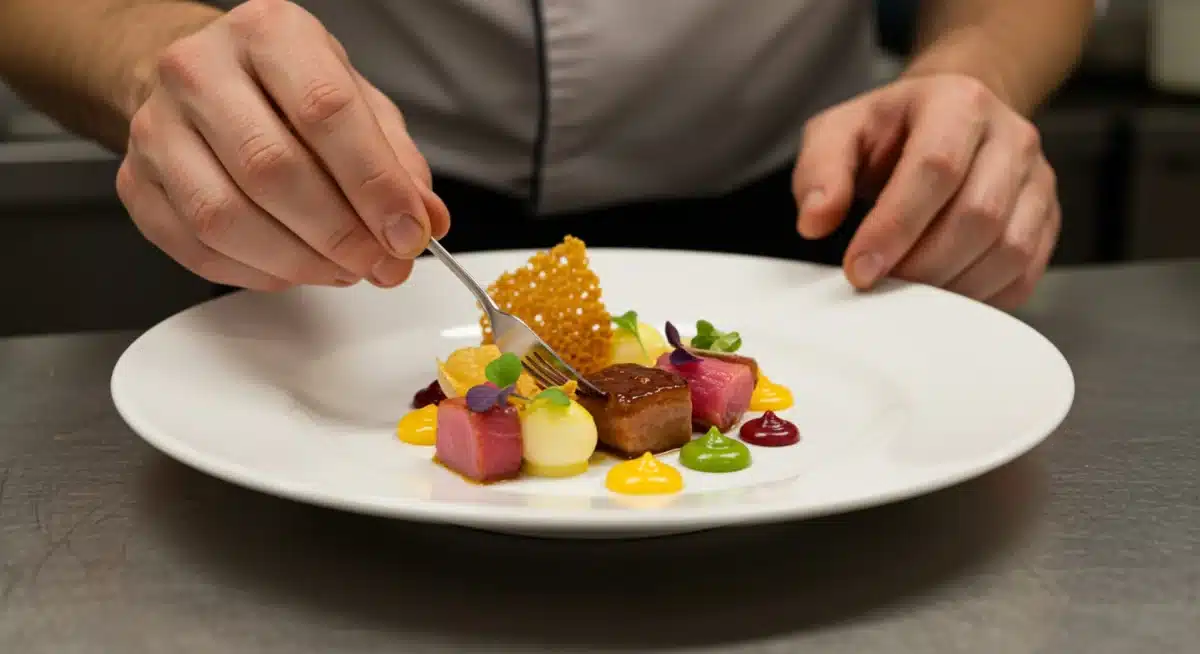Master the Art of Hosting: Ultimate Dinner Party Guide

Master the art of hosting: tips for throwing the perfect dinner party by meticulously planning every detail from guest list and menu to ambiance and post-event follow-up, ensuring a memorable and enjoyable experience for everyone involved.
Are you ready to elevate your entertaining game and truly mastering dinner party hosting? Hosting a dinner party can be one of life’s great pleasures, offering a unique opportunity to connect with loved ones, celebrate special occasions, or simply enjoy good food and conversation. However, the thought of orchestrating the perfect evening can often feel daunting. This comprehensive guide will walk you through every step, transforming potential stress into an enjoyable and rewarding experience. Prepare to impress your guests and create lasting memories with these expert tips and insights.
The foundational pillars of a flawless dinner party
Every successful dinner party begins with a strong foundation. This involves careful planning and consideration of various elements that contribute to the overall experience. Without these pillars, even the most delicious food can fall flat.
Understanding your guests and the occasion is paramount. Are you celebrating a birthday, a promotion, or simply gathering friends? The purpose of your party will influence everything from your menu choices to the level of formality. Knowing your guests’ dietary restrictions, preferences, and personalities allows you to tailor the event to their comfort and enjoyment, making them feel truly valued.
Guest list and theme selection
Begin by crafting a guest list that balances personalities and fosters engaging conversation. Consider how different individuals might interact and aim for a harmonious group dynamic. Once your guest list is set, think about a theme. A theme, whether subtle or overt, can add a layer of fun and cohesion to your party, guiding your decisions on food, decor, and music.
- Curate a balanced guest list: Mix and match personalities for lively discussions.
- Consider dietary needs: Always inquire about allergies and preferences beforehand.
- Choose a cohesive theme: This can simplify menu and decor decisions.
- Set the right tone: Decide if it’s casual, semi-formal, or a special occasion.
Budgeting and timeline management
A realistic budget is essential for avoiding last-minute financial stress. Allocate funds for food, drinks, decorations, and any rented items. Simultaneously, create a detailed timeline for preparation, starting weeks in advance. This timeline should include tasks like sending invitations, grocery shopping, cooking schedules, and setting up the space, ensuring a smooth and organized lead-up to the event.
By diligently addressing these foundational pillars, you lay the groundwork for a truly memorable and enjoyable dinner party, setting yourself up for success long before your first guest arrives. These initial steps are crucial for transforming a simple idea into a perfectly executed event, reflecting your thoughtfulness and dedication as a host.
Crafting the perfect menu: from appetizers to dessert
The menu is often the star of any dinner party, and careful consideration here can make all the difference. Beyond just taste, think about balance, seasonality, and ease of preparation. A well-planned menu reduces stress and enhances the dining experience for everyone.
When designing your menu, consider the flow of the meal. Start with lighter appetizers that stimulate the appetite without being too filling. Progress to a main course that is both satisfying and manageable to prepare, especially if you’re cooking for a crowd. Conclude with a dessert that provides a sweet finish without being overly heavy.
Selecting seasonal and diverse dishes
Embrace seasonal ingredients for the freshest flavors and often, better value. A diverse menu offers something for everyone, catering to a range of palates and dietary needs. Aim for a mix of textures, colors, and flavors across your courses to keep the meal interesting and visually appealing. Don’t be afraid to incorporate dishes that can be prepared in advance, freeing up your time on the day of the party.
- Prioritize seasonal produce: Ensures peak flavor and freshness.
- Balance flavors and textures: Offer a variety to keep the meal exciting.
- Include make-ahead options: Reduces day-of stress and allows for more host interaction.
- Consider dietary restrictions: Plan at least one dish for common restrictions like vegetarian or gluten-free.
Pairing drinks and wine
The right beverages can significantly enhance your meal. Think about wine pairings that complement your main course, or offer a signature cocktail that ties into your theme. Don’t forget non-alcoholic options, such as sparkling water with fruit, homemade iced tea, or a refreshing mocktail, ensuring all guests feel included and catered to. A well-stocked bar, even a simple one, shows thoughtfulness.
By focusing on a balanced, diverse, and thoughtfully paired menu, you create a culinary journey that delights your guests. The effort put into selecting and preparing each dish will be evident, turning your dinner party into a truly memorable gastronomic event. Remember, the goal is to enjoy the process as much as the outcome.
Setting the scene: ambiance and decor
Beyond the food, the atmosphere you create plays a crucial role in your guests’ experience. Ambiance and decor set the mood, making your home feel inviting and special. It’s about creating a multisensory experience that complements your culinary efforts.
Consider how lighting, music, and table settings can transform your dining area. These elements, when thoughtfully combined, create a cohesive and welcoming environment. The goal is to make your guests feel comfortable and relaxed, encouraging lively conversation and enjoyment.
Table setting and centerpieces
A beautifully set table is a centerpiece in itself. Choose linens, dinnerware, and glassware that match your theme or desired level of formality. A visually appealing centerpiece, whether it’s a floral arrangement, candles, or a collection of interesting objects, can elevate the entire table. Ensure centerpieces are not too tall, allowing guests to see and converse across the table easily.
- Select appropriate linens: Match your table setting to the occasion.
- Choose cohesive dinnerware: Creates a polished and elegant look.
- Opt for suitable glassware: Different drinks often require specific glass types.
- Create a balanced centerpiece: Enhance aesthetics without obstructing views.
Lighting, music, and fragrance
These subtle elements have a powerful impact on mood. Soft, warm lighting, perhaps from dimmers or candles, creates an intimate and cozy atmosphere. A carefully curated playlist, playing at a low volume, provides background enhancement without overpowering conversation. A pleasant, subtle fragrance, perhaps from fresh flowers or a lightly scented candle, can complete the sensory experience. Avoid strong artificial scents that might interfere with the aroma of your food.

By paying attention to these details, you transform your dining space into a haven of hospitality. The right ambiance and decor not only impress your guests but also contribute significantly to their overall enjoyment, making your dinner party a truly immersive experience. It’s about crafting an environment where everyone feels at ease and delighted.
The art of effortless hosting: presence and interaction
Once the preparations are complete, the real art of hosting comes into play: being present and engaging with your guests. A truly great host makes everyone feel seen, heard, and valued, ensuring a comfortable and enjoyable atmosphere.
This involves more than just serving food; it’s about facilitating conversation, anticipating needs, and creating an environment where guests can relax and connect. Your presence and genuine interaction are what transform a meal into a memorable gathering.
Greeting guests and facilitating introductions
Welcome each guest warmly at the door, making them feel immediately at home. If guests don’t know each other, take the time to make thoughtful introductions, highlighting common interests to spark conversation. Offer them a drink and show them where to put their coats, easing them into the party flow. A warm welcome sets the tone for the entire evening.
- Offer a genuine welcome: Make guests feel instantly at ease.
- Facilitate natural introductions: Highlight shared interests to break the ice.
- Anticipate initial needs: Provide drinks and directions to amenities.
- Engage actively: Circulate and ensure everyone feels included.
Managing the flow of the evening
While a rigid schedule isn’t necessary, having a loose plan for the evening helps maintain a natural flow. Know when you’ll serve appetizers, transition to dinner, and offer dessert. Be flexible, however, and read the room. If conversation is flowing, delay a course slightly. If guests seem ready for the next stage, gently guide them. The goal is a seamless progression that feels organic and unforced, allowing you to enjoy the company as much as your guests do.
An effortless host is one who appears calm and collected, even if there’s a flurry of activity behind the scenes. This composure allows you to be fully present, engaging in conversations and ensuring everyone is having a good time. Remember, your enjoyment is contagious and contributes greatly to the overall success of the party.
Troubleshooting and graceful recovery
Even the most meticulously planned dinner parties can encounter unexpected hiccups. The true measure of a host isn’t avoiding problems entirely, but how gracefully they recover from them. A calm and resourceful approach can turn a potential disaster into a minor anecdote.
Anticipating common issues and having contingency plans in place can significantly reduce stress. Whether it’s a burnt dish, a spilled drink, or an awkward silence, your reaction sets the tone for how guests perceive the situation. Maintain your composure and remember that your guests are there to enjoy your company, not to critique every detail.
Handling culinary mishaps
If a dish doesn’t turn out as planned, don’t panic. Have a simple backup plan, like an easy-to-prepare pasta dish or a gourmet cheese board you can quickly assemble. If something burns, discreetly remove it and open windows to air out the kitchen. Humor can also be a great tool; a lighthearted comment about a cooking adventure can ease any tension. The key is to adapt quickly and maintain a positive attitude.
Sometimes, despite your best efforts, a dish might not suit everyone’s taste. Be prepared to offer alternatives, even if it’s just a simple side dish that can complement the meal. The thoughtfulness of having options is often appreciated more than culinary perfection. Transparency, when handled with grace, can also be charming; guests often appreciate a host who is human and relatable.
Addressing unexpected guest situations
From a spilled drink to an unexpectedly late arrival, guest-related issues can arise. Keep a stain remover handy for spills and address them quickly and discreetly. For latecomers, simply welcome them and help them catch up without making a fuss. If an awkward conversation arises, gently steer it towards a more neutral topic or introduce a new activity. The goal is to ensure everyone feels comfortable and respected, maintaining a positive group dynamic.

The ability to troubleshoot and recover gracefully is a hallmark of an experienced host. It demonstrates resilience and dedication to your guests’ enjoyment, reinforcing the idea that your party is a space for fun and connection, not just perfection. Your calm response will reassure your guests that everything is under control.
The post-party glow: thoughtful follow-up
The success of a dinner party doesn’t end when the last guest leaves. Thoughtful follow-up can extend the positive experience and solidify your reputation as an exceptional host. It’s an opportunity to express gratitude and reinforce connections, leaving a lasting impression.
This final step showcases your appreciation for your guests’ company and allows you to reflect on the event. It’s a small gesture that can have a significant impact, making your guests feel truly valued and eager for future invitations.
Expressing gratitude and feedback
A simple thank-you note, email, or text to your guests within a day or two of the party goes a long way. Express your gratitude for their presence and mention something specific you enjoyed about their company. This personal touch shows you genuinely appreciated their attendance. If appropriate and from close friends, you might also be open to constructive feedback, which can help you refine your hosting skills for future events.
- Send timely thank-you notes: Personalize each message for a special touch.
- Share positive memories: Remind guests of enjoyable moments from the evening.
- Be open to feedback: Use insights to improve future hosting experiences.
- Reinforce connections: Suggest future gatherings or activities.
Efficient cleanup and reflection
While the immediate aftermath might feel like a daunting task, approaching cleanup efficiently can save you energy. Prioritize perishable food storage and initial dishwashing the night of, leaving less urgent tasks for the next day. As you clean, take a moment to reflect on what went well and what could be improved. This self-assessment is invaluable for continuous growth as a host, helping you refine your process for the next gathering.
The post-party phase is more than just tidying up; it’s an integral part of the hosting experience. By thoughtfully following up and reflecting on your event, you not only ensure your guests feel cherished but also continuously enhance your own hosting prowess, making each subsequent dinner party even more delightful and seamless.
| Key Aspect | Brief Description |
|---|---|
| Planning & Preparation | Crucial for success, includes guest list, theme, budget, and timeline. |
| Menu Crafting | Focus on seasonal, diverse dishes, and thoughtful drink pairings. |
| Setting the Ambiance | Decor, lighting, and music create an inviting and comfortable mood. |
| Host Presence | Engaging with guests and managing the evening’s flow gracefully. |
Frequently asked questions about dinner party hosting
Always ask guests about dietary restrictions or allergies when they RSVP. Plan your menu to include at least one or two dishes that cater to common restrictions, such as vegetarian or gluten-free options. Clearly label dishes or inform guests what each dish contains to ensure their comfort and safety.
Start planning about 2-3 weeks out: send invitations, finalize your guest list, and choose a theme. One week before, plan your menu, grocery list, and delegate tasks if needed. The day before, do major prep work. On the day of, focus on final cooking, setting the table, and personal grooming.
Focus on soft lighting, a curated music playlist at a low volume, and a clean, clutter-free space. A well-set table with a tasteful centerpiece and fresh flowers adds visual appeal. Ensure comfortable seating and a pleasant, subtle scent to make guests feel relaxed and at home.
As the host, you can facilitate introductions by mentioning shared interests between guests. Have a few open-ended questions in mind to spark discussion, like recent travels or interesting news. Encourage guests to move around and mingle before and after dinner to foster different conversational groups.
Stay calm and address issues discreetly. For culinary mishaps, have a simple backup or make a lighthearted joke. For spills, have cleaning supplies ready. Your composed reaction will reassure guests that everything is fine, maintaining a relaxed and enjoyable atmosphere for everyone.
Conclusion
Mastering dinner party hosting is a journey of continuous learning, creativity, and connection. By embracing thoughtful planning, crafting a delightful menu, setting an inviting scene, and engaging genuinely with your guests, you transform a simple meal into an unforgettable experience. Remember, the true essence of hosting lies not in perfection, but in the warmth, generosity, and joy you share with those around your table. Every detail, from the initial invitation to the final thank you, contributes to a harmonious and memorable event. Embrace the process, trust your instincts, and revel in the happiness you create.





